Ephemera: Doris Edith May Orridge’s Autograph Book, Essex School Chums, and a Christmas Football Game at the Front (no, not that one)
For the third entry in the series, a very battered, missing its front cover — as well perhaps half of its original contents — autograph book which once belonged to a Doris Edith May Orridge (1896 -1988), who attended St Margaret School, a mixed aged and sex, boarding school in Leigh-on-Sea, Essex. She attended with her younger sister Gladys and they were the daughters of Kathleen and Charles Orridge, a commercial clerk, and according to the 1901 census, they lived in East Ham London. 1

The book contains 33 entries made, where identifiable, between 1 April 1912 and 26 December 1914, and, as autograph books goes, it is a rather fun affair as it has mainly been filled in by her school chums; containing numerous copies of cartoons and postcards of the day, as well as humorous rhymes and spoofs. An acrostic poem (Figure 1) left by one of her classmates — in tandem with the 1911 census — has made it possible to identify the owner.
I was not planning to purchase any more autograph books until I had made some headway in cataloguing my collection so far, but as this book was, cheap, battered and broken, I thought it would be a suitable candidate for experimenting with photographing (more below in the technical bit) and because it had this fantastic cartoon in it (Figure 2).
The Entries

I was also pleasantly surprised to find a copy of an Arthur Moreland cartoon (Figure 3), copied from his 1902 book Humours of History, as this is a book I have in my own collection.

What I was not expecting to find, however, was within this pot of school chums, three entries made by Officers. The first was made by Thomas Oswell Bury (1883-1961), 4th Battalion, Royal Welch Fusiliers — one of the first territorial regiments to be sent to France.
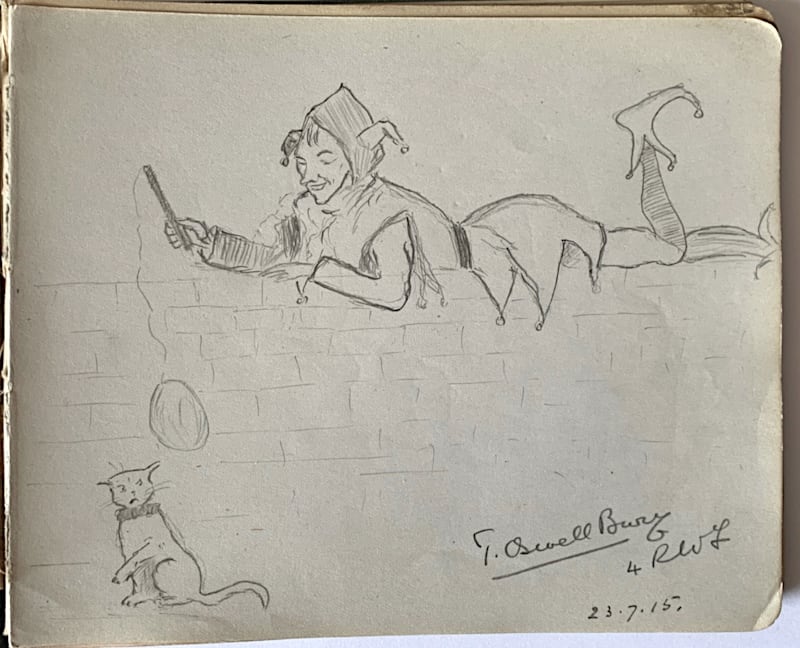
Bury had quite the military career: a Wrexham solicitor and member of Wrexham Town council, he joined the territorials in 1904. In August 1914 he was mobilised with the rank of Captain and moved swiftly up the ranks, becoming a Lieutenant Colonel in 1918, and would later command the 1/20 Battalion, London Regiment (Blackheath and Woolwich).2 An article from February 1915 mentions Bury leading the support in an attack in the Givenchy area, a commune in Northern France, which led to fierce hand-to-hand combat, with Bury having to move his men along an open road exposed to the enemy's machine guns. The battalion received thanks and appreciation from Sir John French for their vices.3 A later article in May of the same year notes that he had been wounded and invalided home, and an article in June notes he had been mentioned in dispatches — also noting that he is one of three brothers holding commissions in the battalion. He would, in the same month, be promoted to acting-Major and then Major in September that year.4 The unit diary notes that his injury occurred at the end of March, around Neuve Chappelle, holding dugouts that were previously occupied by the Germans, where they were coming under shelling on a daily basis.5 It appears he spent some time in a hospital in France, before convalescing in England, and then headed back to France around August/September of the same year.
His relationship to the book's owner is a mystery — perhaps a friend of the family?
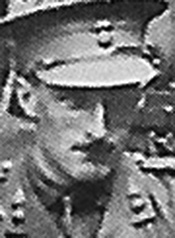
The second officer's entry to appear is by Ernest Ronald Shuttleworth (1894-1916), 8th Battalion Royal Warwickshire Regiment. Shuttleworth was born in Sheffield and educated at Quenford House School, Jersey. His civilian occupation is listed as a Chartered Accountants' Clerk. His grandfather and his father, Thomas Ernest Shuttleworth, were also in accountancy and traded as T.G. Shuttleworth and Sons, Chartered Accountants — located at the Royal Insurance Building, Church Street, Sheffield — both also seemed to have been quite proficient chess players.6

On the outbreak of war, Shuttleworth originally enlisted in the Public Schools Battalion, Royal Naval Division, as an ordinary seaman, but was later commissioned as a Second Lieutenant into the Warwicks in April 1915.7 A family story goes that during the departure for Gallipoli, Ernest fell down a companion ladder and broke his leg. After his recuperation, he was persuaded to take his commission in the Royal Warwicks.8
Shuttleworth would fall on the first day of the Somme, at HeidenKopf Redoubt, aged just 22. The unit diary describes the events as follows:
7.30am Advance begins, Enemy first line reached and passed very quickly as also was the second. Only in one or two cases were any enemy seen in those two lines. Having plenty of casualties from machine gun fire in enemy third and fourth line.
At the third line we were temporarily held up by machine gun fire but took it by rushes from this point. The fighting was all with bombs along trenches. We reached our objective probably 35-40 minutes from Zero hour (7.30am) and at once commenced consolidating and clearing rifle fire towards the direction of Captain Martin and 2nd Lt Turner. By this time the next battalion was arriving but had had so many causalities that they could not go through and so helped consolidating. This happened with all battalions following us.
Many times we were bombed from this position and regained it until bombs ran out! We had to retire to the 3rd line, line the parapets, and hold on with machine and rifle fire. Parties of men detailed to collect as many bombs as could be found (both English & German) and when we had a good store we again reached our objective. No supply of bombs were coming from rear so could not hold and retired again. Enemy machine guns and snipers were doing a great amount of damage all the while. Enemy artillery opened but fortunately their range was over. Held on to this position until relieved by a battalion from rear. All throughout the action no troops were seen on our right or left. This had a great deal to with the inability to push past our objective.9
The unit diary then goes on to lists the casualties: 8 officers killed, 12 wounded (including Shuttlesworth — later reported missing), one wounded and missing, and one wounded and captured. For the other ranks, 57 killed, 255 wounded, and 251 missing. He is commemorated at the Thiepval Memorial, and there is a private memorial in Sheffield General Cemetery.
His father would pass away in 1922, aged just 57, and the following is from his obituary that appeared in the Sheffield Daily Telegraph, which needs no further commentary:
The eldest son of the late Mr. Shuttleworth served in the Great War, and was with the City Battalion in the "Great push" which was made on July 1st, 1916. He was one of the soldiers reported missing, and the loss of his boy interfered seriously with the health of Mr. T. E. Shuttleworth, so much so that he never fully rallied from the shock. Moreover, Mr. Shuttleworth had to contend with an abnormal pressure of business, and this hastened the breakdown which led to his final illness.10
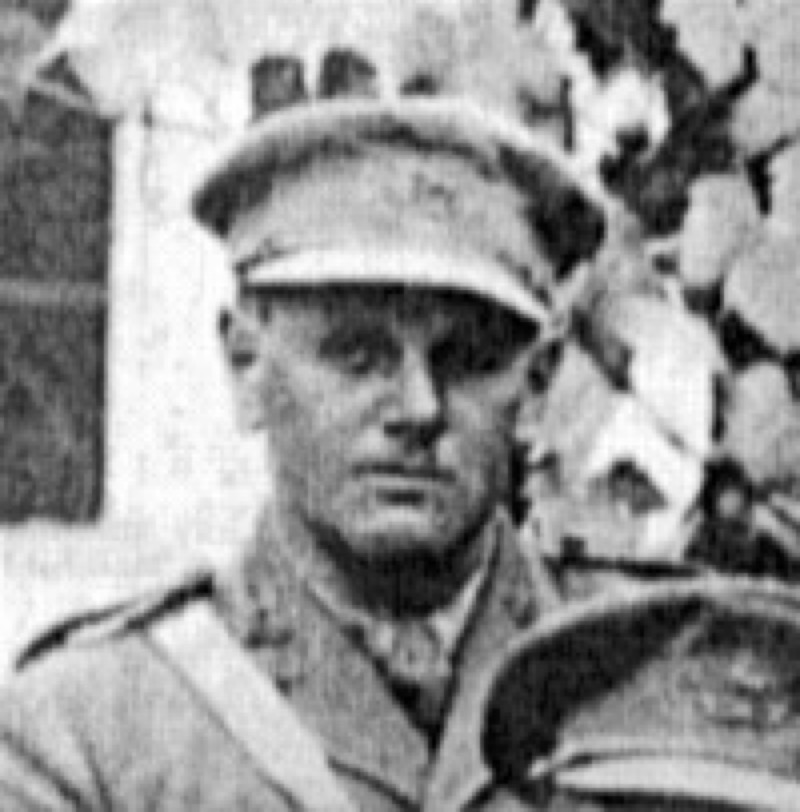
Thanks to Terry Carter, author of the Birmingham Pals, for the photograph of Shuttleworth.11

The third entry was made by George Meborn Hubbard (1895-1968), who was born in Camberwell, London, and joined the Honourable Artillery Company on 14 August 1914 — his address given as 47 Endymion Road, Brixton Hill, London.12 He was commissioned into the 8th Royal Warwicks as a 2nd Lieutenant, two days before Shuttleworth.13 It was common, at the time, for men who had been promoted from the ranks to attend a short course, and a period with a reserve battalion. The 2nd line of the South Midland Division was stationed, when these entries were written, in Chelmsford, Essex.14 Given the proximity and the ages of all involved (Doris was 18, Hubbard 20, and Shuttleworth 21) it is not too much of a stretch to imagine their paths crossing.
On a lighter note, to end this section, while researching these entries I came across a letter, written by Sergeant F. B. Freeman to the Birmingham Daily in January 1916. The letter is an account of a football game that took place on 14 December 1916 'Somewhere in France' (the unit diary has them in rest at Bayencourt — also noting the day before they had all been for a battalion bath, and their uniforms had been deloused15), between the Officers and the NCOs of the 8th Royal Warwicks, which was followed the next day by the 'Battle of the Corks' — the Annual Sergeants Dinner. The letter mentions both Shuttleworth and Hubbard by name.
Shuttleworth is listed as being on the Officers football team; the game kicked off at 2.45pm and by half-time the Sergeants were leading 2 to 1. When the Officers levelled the score in the second half, a few zealous supporters attempted to barricade the Sergeant's goal with stretchers and trench-boards, but their efforts were unnecessary as the Sergeants went on to win 3-2.
For the Sergeants' dinner, the local village had been scoured for crockery, a suitable location found, and an invitation extended to the officers — meaning some 70 people were in attendance. Sergeant Walliter and his assistant cooks whipped up a meal of oxtail soup, roast chicken, sausages, croquets, peas and bread sauce. To satisfy the 'Oliver Twists', more was provided in the way of leg of mutton, boiled potatoes, mashed turnips, carrots, and onion sauce. Desert was a Christmas pudding served with brandy sauce, and the whole affair was finished with biscuits and cheese.
With the food having been served, the night moved on to the 'Battle of the Corks'. In a one-finger salute to the No-Treating Act — an unpopular 1915 law introduced under the Defence of the Realm act which stated you were not allowed to buy someone a drink, champagne, whisky, sherry, port, and plenty of "real English ale' was distributed to make sure the participants lived up to the motto printed on the menu cards: 'Eat, drink, and be merry for tomorrow ye may die'. A concert then followed, with one of the singers none other than Hubbard, who sang three songs: 'Mountains of Morne', 'Chorus Gentlemen Please!', and 'The Blue Dragoon'.
Colonel Innes then raised a toast to the men and the night closed with everyone joining in singing a revised version of 'The Hymn of Hate', which Freeman writes 'was a fitting termination to an evening which will live in the memory of those privileged to be present'.16
Language
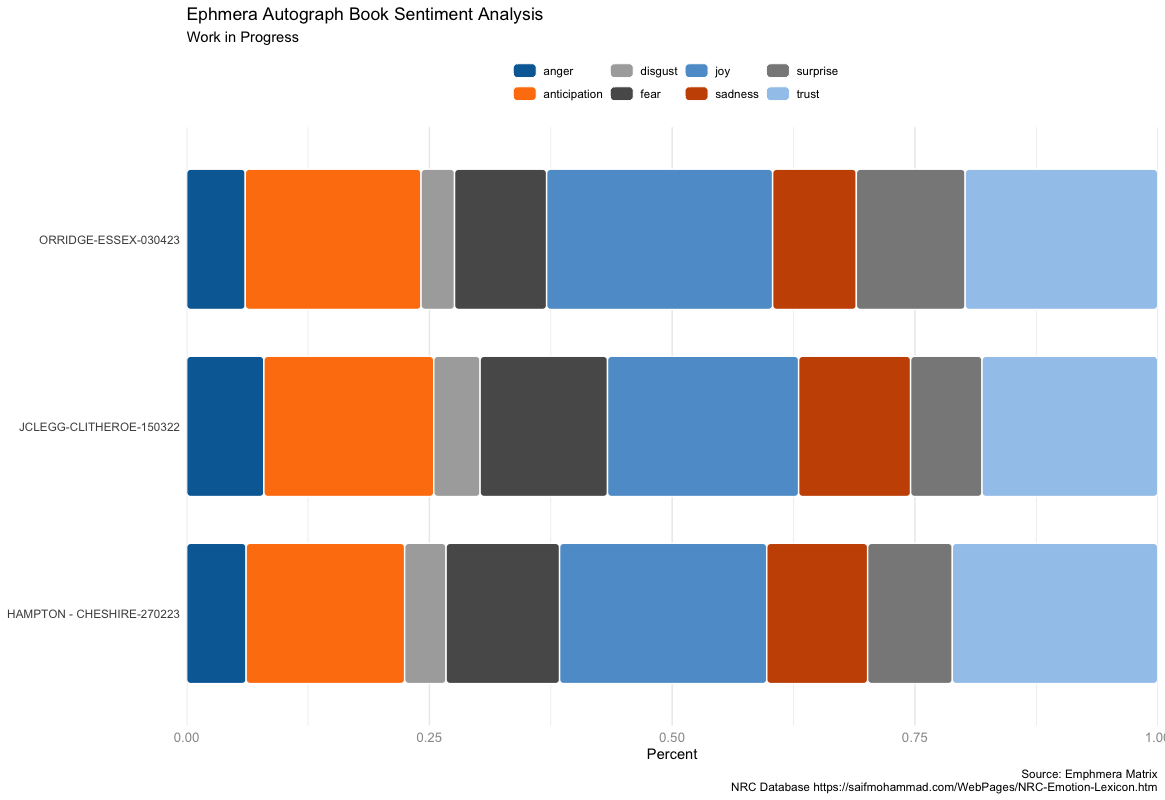
As I mentioned in the introduction, this is a 'fun' autograph book. I was curious to see if that was reflected in the language used, so I ran it against the NRC (National Research Council Canada) word-emotion associated lexicon.17 This is a database of words associated with eight basic emotions and it indicates whether the words are positive or negative.
There are several caveats to consider here, which will be explored in more detail as this project develops, but for now, be aware that as the NRC is a recent creation it reflects modern language usage. In addition, as the sample size is currently tiny, the following can only be treated as indicative.
What is interesting, however, is that Orridge's book contains a lot more joy and surprise, and marginally more anticipation, than the other books surveyed so far. It is also interesting that Jennie Clegg's collection of Methodist material has come out filled with more sadness, fear, and anger than the other two. To stress, this is only indicative.
As before, all the entries can be found here and are shared under a creative commons licence.
The entries for Doris's autograph book can be found in the folder 'ORRIDGE-ESSEX-030423'. There is a text document and photograph for each page. A spreadsheet called MasterRecord, in the root directory, contains the meta-data.
The Technical Bit
Behind sharing my ephemera collection, I am also plotting these entries onto a matrix to model them. This is very much a work-in-progress and the following are some notes on the process — which may be of limited interest.
The chart for the sentiment analysis can be found in the file LanguageAnalysis-WIP
As in the previous entry in this series, the matrix column headings are very much a work in progress and if anything, the matrix is getting even more messier — which is a good thing, and I will expand on why in the next entry in this series.
In terms of photography; I can broadly breakdown my collection into three categories: Fragile, Broken — such as this book, handle with care — the overwhelming bulk of my collection, and Caution! — items both delicate and potentially important (about 10% of my collection).
The following does not apply to items in the latter, and I am considering whether it is worth either getting the items scanned professionally, or further investment in equipment — most notably lighting. However, I have managed, after much trial and error, to come up with a method for capturing the books, which hasn't cost the earth, and will suffice for the bulk of my collection.
The items involved are:
-
Mobile phone, flexible arm clamp which attaches to my desk
-
Mobile phone Bluetooth camera remote (very important)
-
Archival book cushion
-
Recipe book holder
The best lighting I have found is a north-facing window, and a slightly overcast day.
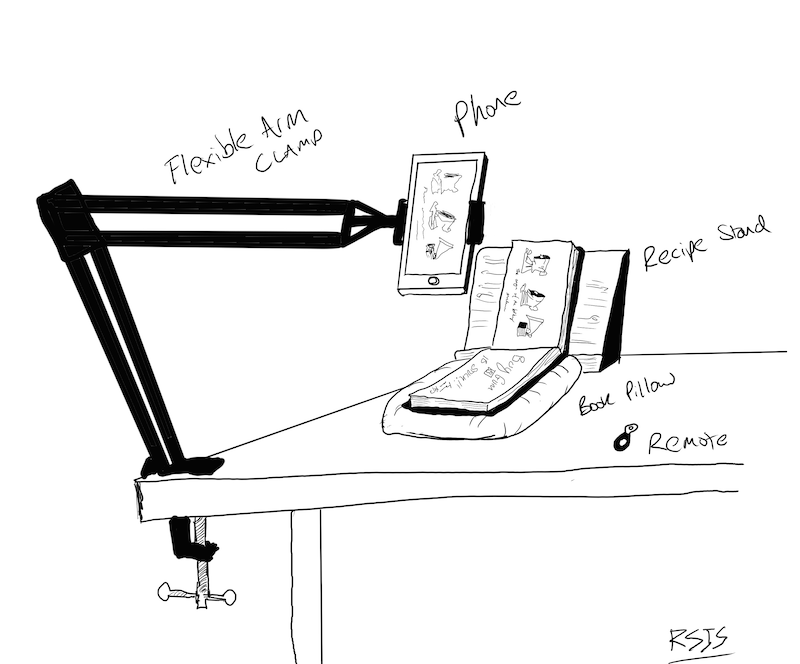
As in figure 10, the book is placed on the recipe stand, with the cushion at the base to protect the spine. The camera is then angled to match the angle on the stand. Using the remote, I can flick through the book quickly, and snap all the odd pages. It is then a case of flipping the book, to snap all the even pages.
The results are good enough for my purposes and, as the light is uniform, it is fairly straightforward to clean the images further in a package like Gimp.

Figure 11 was achieved using the Grain Merge and Grain Extract features. First I duplicated the image, applied a gaussian blur and selected Grain Extract. Duplicating the original image again, I then selected Grain Merge. This makes the middle greys more grey, which means the blacks and whites can be adjusted, via the level options, to remove a lot of the noise very quickly — this is also a handy method when dealing with scanned archived documents.
-
She married Walter J Webber in 1931; 1901 Census England and Wales; 1911 Census England and Wales; England & Wales Deaths 1837-2007. ↩︎
-
R. A. Pinsent, Record of Service of Solicitors and Articled Clerks with his Majesty's Forces 1914-1919 (London: Spottiswoode, Ballantyne & Co, 1920), p.80. ↩︎
-
Liverpool Daily Post, 25 February 1915, p.6. ↩︎
-
Chester Chronicle, 1 May 1915, p.8*; Liverpool Echo*, 23 June 1915.p.5; Liverpool Daily Post, 30 June 1915, p.8; London Gazette, 16 September 1915, 9209. ↩︎
-
TNA/WO95/1280/2/47, The War Diary of the 4th Battalion Royal Welch Fusiliers. ↩︎
-
https://mannchess.org.uk/People/Shuttleworth,%20TG%20and%20TE.htm, retrieved 4 August 2023. ↩︎
-
https://www.masonicgreatwarproject.org.uk/legend.php?id=2807, retrieved 3 August 2023; https://mannchess.org.uk/People/Shuttleworth,%20TG%20and%20TE.htm retrieved 3 August 2023. ↩︎
-
https://www.greatwarforum.org/topic/281865-getting-a-commission/#comment-3016459, retrieved 8 August 2023. ↩︎
-
TNA/WO95/2756/2, The War Diary of the 8th Royal Warwickshire's. ↩︎
-
Sheffield Daily Telegraph, 14 June 1922, p.4. ↩︎
-
Terry Carter, Birmingham Pals (York: Pen & Sword, 2011). ↩︎
-
HAC Vellum Membership Book, October 1908-1914; HAC 1915-1919 Membership List. ↩︎
-
London Gazette, 7 April 1915, 3424; Monthly Army Lists, October 1915. ↩︎
-
http://www.longlongtrail.co.uk/army/order-of-battle-of-divisions/61st-2nd-south-midland-division/, retrieved 4 August 1923. ↩︎
-
TNA/WO95/2756/2, The War Diary of the 8th Royal Warwickshire's. ↩︎
-
Birmingham Mail, 18 January 1916, p.2; 'Hymn of Hate' was an attempt by German propagandists to stir up anti-British sentiments, which spectacularly backfired. The song, penned by Ernst Lissauer in 1915, was distributed widely both in Germany and abroad. In the same year, however, the Royal College of Music decided to parody the song as a joke, and this was followed by the music hall, and it soon became an object of ridicule. ↩︎
-
https://saifmohammad.com/WebPages/NRC-Emotion-Lexicon.htm, retrieved 11 August 2023. ↩︎